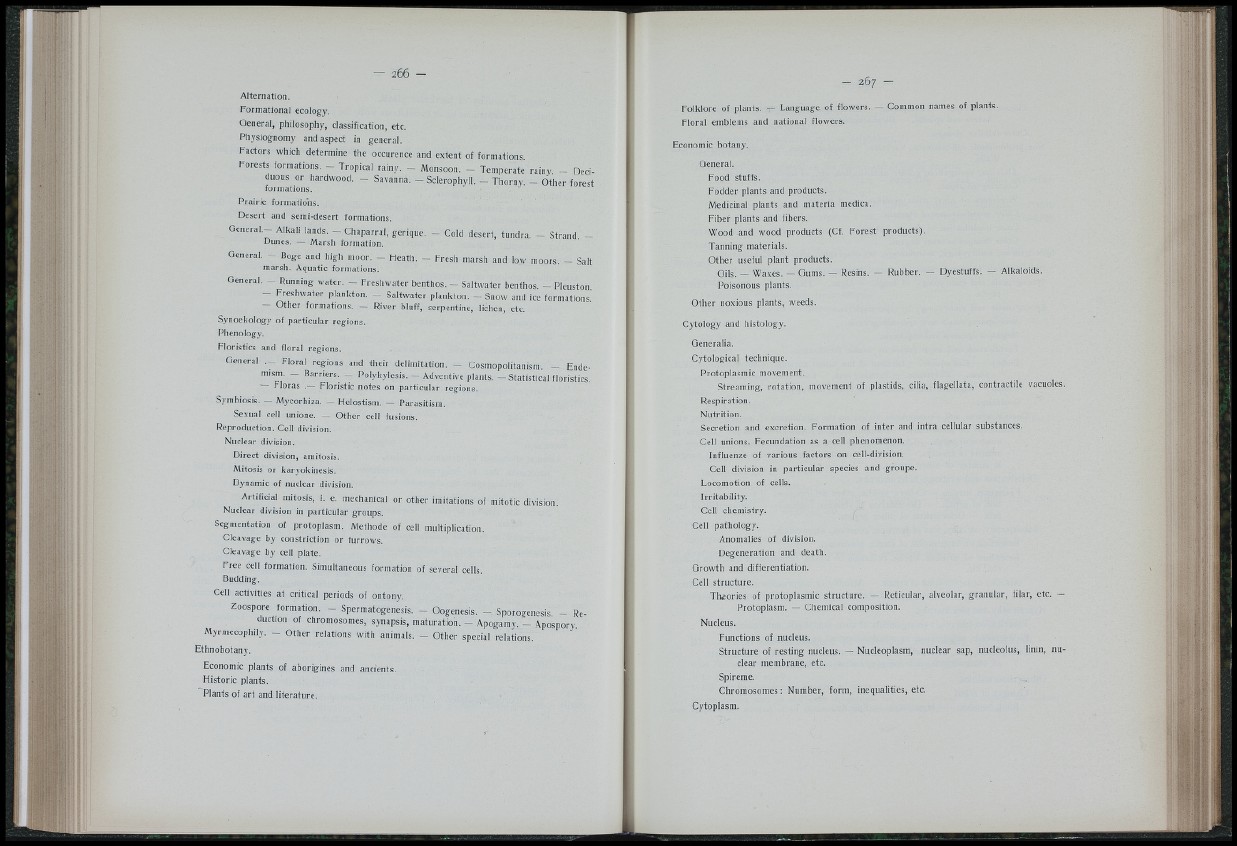
Alternation.
Formational ecology.
General, philosophy, classification, etc.
Phys iognomy and aspect in general.
Factors which determine the occurence and extent of formations.
Forests formations. - Tropical rainy. - Monsoon. - Temperate rainy - Deciduous
or hardwood. - Savanna. - Sclerophyll. - Thorny. - Gther forest
formations.
Prairie formations.
Ffesert and semi-desert formations.
General.— Alkali lands. — Chaparral, gerique. — Cold desert, tundra. — Strand. -
Dunes. — Marsh formation.
General. - Boge and high moor. - Heath. - Fresh marsh and low moors. - Salt
marsh. Aquatic formations.
General. — Running water. — Freshwater benthos. — Saltwater benthos. — Pleuston.
— Freshwater plankton. — Saltwater plankton. — Snow and ice formations
— Gther formations. - River bluff, serpentine, lichen, etc.
Synoekology of particular regions.
Phenology.
Floristics and floral regions.
General .— Floral regions and their delimitation. — Cosmopolitanism — Endemism.
- Barriers. - Polykylesis. - Adventive plants. - Statistical floristics
Floras .— Flonstic notes on particular regions.
Symbiosis. — Mycorhiza. — Helostism. — Parasitism.
Sexual cell unione. — Gther cell fusions.
Reproduction. Cell division.
Nuclear division.
Direct division, amitosis.
Mitosis or karyokinesis.
Dynamic of nuclear division.
Artificial mitosis, i. e. mechanical or other imitations of mitotic division.
Nuclear division in particular groups.
Segmentation of protoplasm. Methode of cell multiplication.
Cleavage by constriction or furrows.
Cleavage by cell plate.
Free cell formation. Simultaneous formation of several cells.
Budding.
Cell activities at critical periods of ontony.
Zoospore formation. - Spermatogenesis. - Gogenesis. - Sporogenesis. - Reduction
of chromosomes, synapsis, maturation. - Apogamy. - Apospory.
Myrmecophily. — Gther relations with animals. — Gther special relations.
Ethnobotany.
Economic plants of aborigines and ancients.
Historic plants.
Plants of art and literature.
Folklore of plants. - - Language of flowers. — Common names of plants.
Floral emblems and national flowers.
Economic botany.
General.
Food stuffs.
Fodder plants and products.
Medicinal plants and materia medica.
Fiber plants and fibers.
Wood and wood products (Cf. Forest products).
Tanning materials.
Gther useful plant products.
Gils. — Waxes. — Gums. — Resins. — Rubber. — Dyestuffs. — Alkaloids.
Poisonous plants.
Gther noxious plants, weeds.
Cytology and histology.
Generalia.
Cytological technique.
Protoplasmic movement.
Streaming, rotation, movement of plastids, cilia, flagellata, contractile vacuoles.
Respiration.
Nutrition.
Secretion and excretion. Formation of inter and intra cellular substances.
Cell unions. Fecundation as a cell phenomenon.
Influenze of various factors on cell-division.
Cell division in particular species and groupe.
Locomotion of cells.
Irritability.
Cell chemistry.
Cell pathology.
Anomalies of division.
Degeneration and death.
Growth and differentiation.
Cell structure.
Th io r ie s of protoplasmic structure. — Reticular, alveolar, granular, filar, etc. —
Protoplasm. — Chemical composition.
Nucleus.
Functions of nucleus.
Structure of resting nucleus. — Nucleoplasm, nuclear sap, nucleolus, limn, nuclear
membrane, etc.
Spireme.
C h r omo some s : Number, form, inequalities, etc.
Cytoplasm.